The Intel NUC8i7HVK (Hades Canyon) Review: Kaby Lake-G Benchmarked
by Ganesh T S on March 29, 2018 1:00 PM EST4K HTPC Credentials
The noise profile of the NUC8i7HVK is surprisingly good. At idle and low loads, the fans are barely audible, and they only kicked in during stressful gaming benchmarks. From a HTPC perspective, we had to put up with the fan noise during the decode and playback of codecs that didn't have hardware decode acceleration - 4Kp60 VP9 Profile 2 videos, for instance. Obviously, the unit is not for the discerning HTPC enthusiast who is better off with a passively cooled system.
Refresh Rate Accuracy
Starting with Haswell, Intel, AMD and NVIDIA have been on par with respect to display refresh rate accuracy. The most important refresh rate for videophiles is obviously 23.976 Hz (the 23 Hz setting). As expected, the Intel NUC8i7HVK (Hades Canyon) has no trouble with refreshing the display appropriately in this setting.
The gallery below presents some of the other refresh rates that we tested out. The first statistic in madVR's OSD indicates the display refresh rate.
Network Streaming Efficiency
Evaluation of OTT playback efficiency was done by playing back the Mystery Box's Peru 8K HDR 60FPS video in YouTube using Microsoft Edge and Season 4 Episode 4 of the Netflix Test Pattern title using the Windows Store App, after setting the desktop to HDR mode and enabling the streaming of HDR video.
The YouTube streaming test, unfortunately, played back a 1080p AVC version. MS Edge utilizes the Radeon GPU which doesn't have acceleration for VP9 Profile 2 decode. Instead of software decoding, Edge apparently requests the next available hardware accelerated codec, which happens to be AVC. The graph below plots the discrete GPU load, discrete GPU chip power, and the at-wall power consumption during the course of the YouTube video playback.
Since the stream was a 1080p version, we start off immediately with the highest possible bitrate. The GPU power consumption is stable around 8W, with the at-wall power consumption around 30W. The Radeon GPU does not expose separate video engine and GPU loads to monitoring software. Instead, a generic GPU load is available. Its behavior is unlike what we get from the Intel's integrated GPUs or NVIDIA GPUs - instead of a smooth load profile, it has frequent spikes close to 100% and rushing back to idle, as evident from the red lines in the graphs in this section. Therefore, we can only take the GPU chip power consumption as an indicator of the loading factor.
A similar graph for the Netflix streaming case (16 Mbps HEVC 10b HDR video) is also presented below. Manual stream selection is available (Ctrl-Alt-Shift-S) and debug information / statistics can also be viewed (Ctrl-Alt-Shift-D). Statistics collected for the YouTube streaming experiment were also collected here.
It must be noted that the debug OSD is kept on till the stream reaches the 16 Mbps playback stage around 2 minutes after the start of the streaming. The GPU chip power consumption ranges from 20W for the low resolution video (that requires scaling to 4K) to around 12W for the eventually fetched 16 Mbps 4K stream. The at-wall numbers range from 60W (after the initial loading spike) to around 40W in the steady state.
Update: I received a request to check whether the Netflix application was utilizing the Intel HD Graphics 630 for PlayReady 3.0 functionality. The screenshot below confirms that the 4K HEVC HDR playback with Netflix makes use of the Radeon RX Vega M GH GPU only.
Decoding and Rendering Benchmarks
In order to evaluate local file playback, we concentrate on Kodi (for the casual user) and madVR (for the HTPC enthusiast). Under madVR, we decided to test out only the default out-of-the-box configuration. We recently revamped our decode and rendering test suite, as described in our 2017 HTPC components guide.
madVR 0.92.12 was evaluated with MPC-HC 1.7.15 (unofficial release) with its integrated LAV Filters 0.71. The video decoder was set to Direct 3D mode, with automatic selection of the GPU for decoding operations. For hardware-accelerated codecs, we see the at-wall power consumption around 35-40W and the GPU chip power consumption to be around 10W. For the software decode case (VP9 Profile 2), the at-wall power consumption is around 90W, and the GPU chip power consumption is around 18W (the power budget is likely for madVR processing of the software-decoded video frames).
One of the praiseworthy aspects of the madVR / MPC-HC / LAV Filters combination that we tested above was the automatic switch to HDR mode and back while playing the last couple of videos in our test suite. All in all, the combination of playback components was successful in processing all our test streams in a smooth manner.
The same testing was repeated with the default configuration options for Kodi 17.6. The at-wall power consumption is substantially lower (around 30W) for the hardware-accelerated codecs. The GPU chip power is around 8W consistently for those. For the VP9 Profile 2 case, the at-wall number rises to 70W, but, there is not much change in the GPU chip power. We did encounter a hiccup in the 1080i60 VC-1 case, as the playback just froze for around 5 - 10s - evident in the graph below (the files were being played off the local SSD).
We attempted to perform some testing with VLC 3.0.1, but, encountered random freezes and blank screen outputs while using the default configuration for playing back the same videos. It is possible that the VLC 3.0.1 hardware decode infrastructure is not as robust as that of the MPC-HC / LAV Filters 0.71.0 combination, and the hardware acceleration APIs behave slightly differently with the Radeon GPU compared to the behavior seen with Intel's integrated GPU and NVIDIA's GPU.
Moving on to the codec support, while the Intel HD 630 is a known quantity with respect to the scope of supported hardware accelerated codecs, the Radeon RX Vega M GH is not. DXVA Checker serves as a confirmation for the former and a source of information for the latter.
We can actually see that the codec support from the Intel side is miles ahead of the Radeon's capabilities. It is therefore a pity that users can't somehow set a global option to make all video decoding and related identification rely on the integrated GPU.
Intel originally claimed at the launch of the Hades Canyon NUCs that they would be able to play back UltraHD Blu-rays. The UHD BD Advisor tool from CyberLink, however, presented a different story.
After a bit of back and forth with Intel, it appears that the Hades Canyon NUCs will not be able to play back UHD Blu-rays. Apparently, the use of the Protected Audio Video Path (PAVP) in the integrated GPU is possible only if the display is also being driven by the same GPU. It turned out to be quite disappointing, particularly after Intel's promotion of UHD Blu-ray playback and PAVP as unique differentiating features of the Kaby Lake GPU.










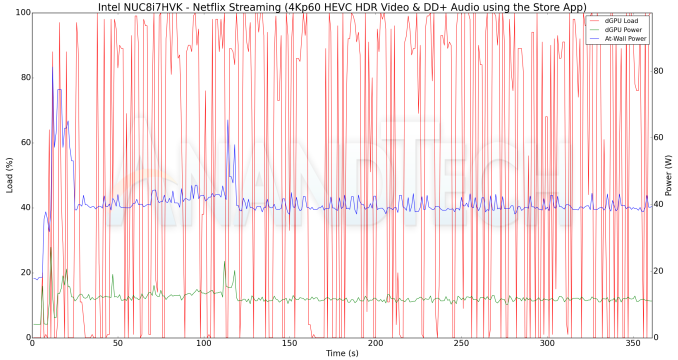
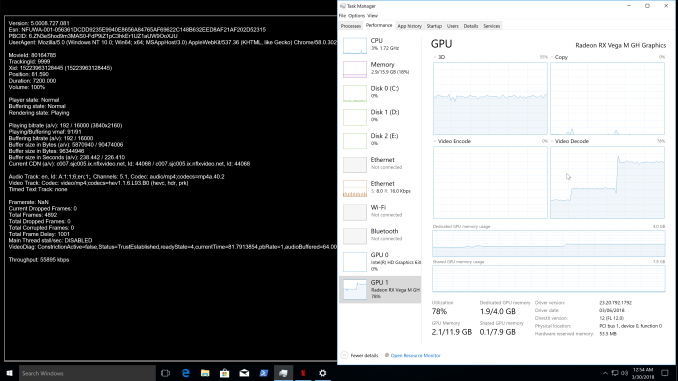
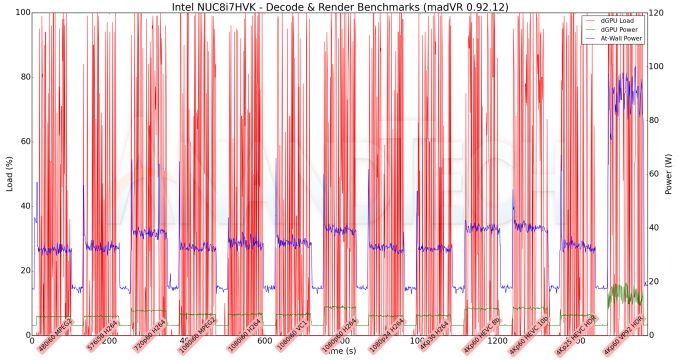
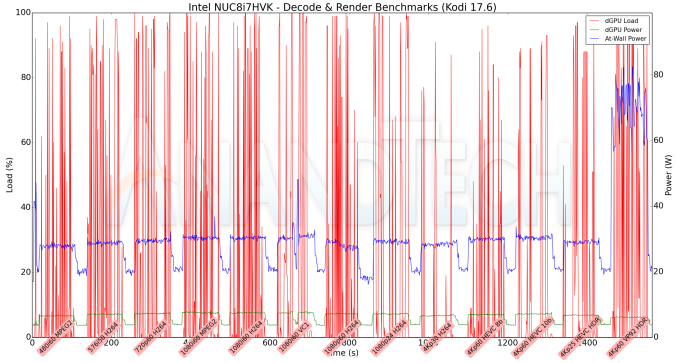
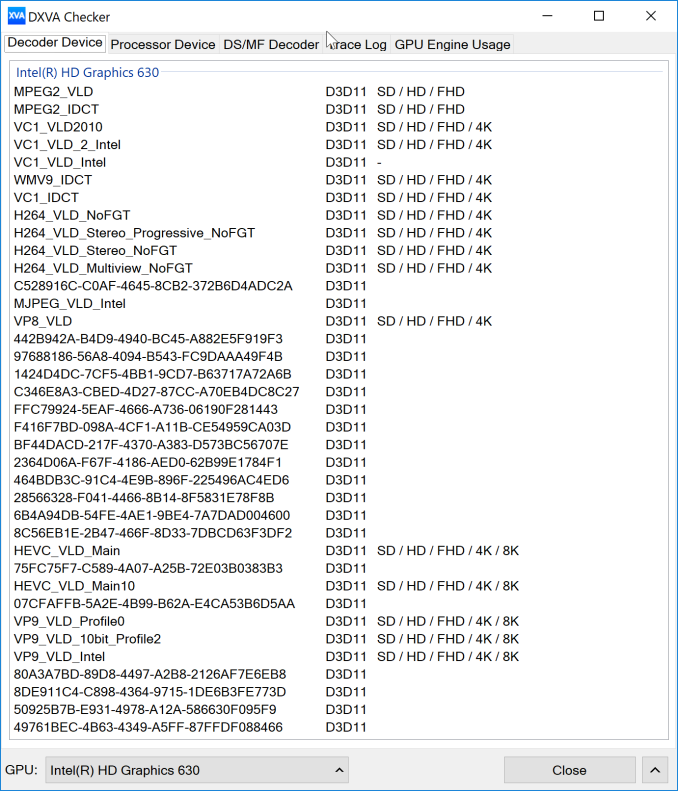
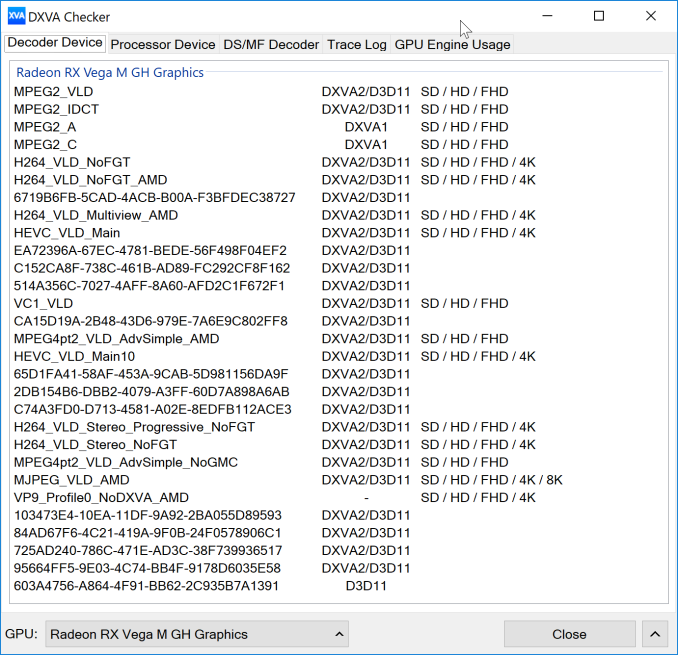
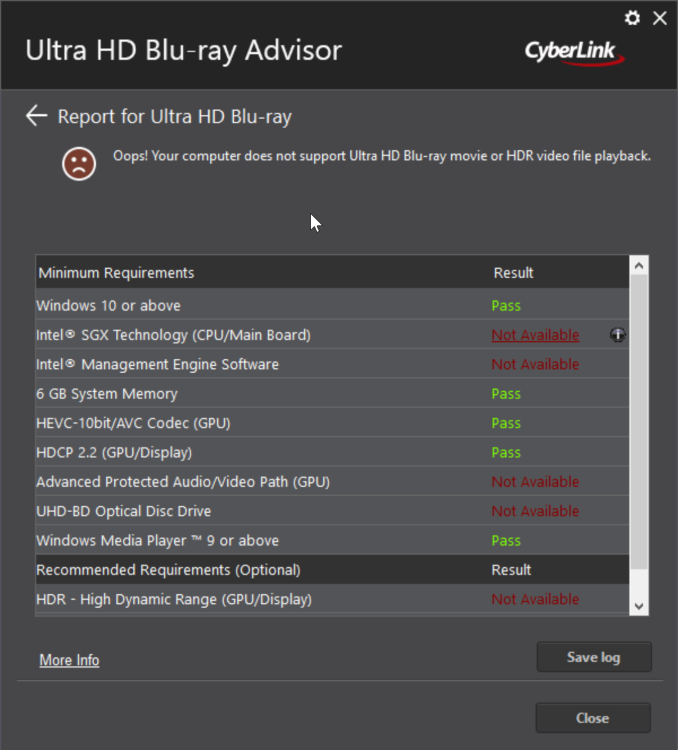








124 Comments
View All Comments
MattEm - Wednesday, April 11, 2018 - link
Can the Hades Canyon be powered by Thuderbolt port or do you need to use the power brick? I am wondering whether I can just plug it into my dell tb dock.HStewart - Sunday, April 15, 2018 - link
One of the biggest problems these 880xG based laptops as I been playing around with my XPS 15 2in1 ( 8805G ) is that a lot of software especially games do not know how to handle it.The best example is Steam VR Test application, even though the software on laptop indicates that CPU is designated to run on the Vega. The Steam VR applications indicated it running on Intel 620. Thus giving it a low score. I have a friend pre-order the Vive headset and thought I give the test application a try - but I search the web on headset and a lot of people are returning them - so this mabe a steam VR issue only.
Eastman - Tuesday, April 17, 2018 - link
Does anyone know if the Hades Canyon will support AMD's Pro Radeon Software? I'm wondering since it's got a Vega M GPU. If it will this would make a fantastic portable workstation solution for me.josehdx - Thursday, April 19, 2018 - link
Can anyone verify this update? https://downloadcenter.intel.com/download/27718/In...Intel says the next coments: Intel SGX software is required:
If SGX security is enabled in BIOS.
To play UHD Bluray content.
So, is it capable to play UHD after the update?
Thanks!
sevenup75 - Wednesday, June 27, 2018 - link
I have downloaded and tried install it but failed.But my 8809g do play UHD Blurays fine.
nagus - Sunday, May 6, 2018 - link
I appreciate your in depth guide. I am the owner of a skull canyon NUC with no HDR support. I was saddened by this because I figured mini displayport > HDMI 2.0a adapter was going to do the trick. Anyways looking for an upgrade model that will support HDR nicely. After reading about the issues the Vega gpu has with HDR support I think I will wait for the next round of NUCs.temptation1234 - Saturday, June 2, 2018 - link
Chuwi HiGame is more VFM , I guess.1.Higame has 8GB DDR4 Memory,Canyon no
2.Higame has 128GB/256GB SSD, Canyon no
3.Higame has Windows 10 OS,Canyon no
sevenup75 - Wednesday, June 27, 2018 - link
Got a Intel NUC 8809G for 3 days.And it do play back UHD Blu-rays. The only problem is Cyberlink Powdvd 18 and UHD BD Advisor tool cann't detect the LG UK850 HDR display and PD18 played in SDR format. But Potplay can play back HDR UHD BDs fine.
Also find there are differences between the TB 3/DP 1.4/HDMI 2.0 ports: TB 3 cannot show the Intel NUC logo during the boot, only support 8bit SDR color; HDMI 2.0 support 8bit HDR color; only DP 1.4 support 10bit HDR output.
btw, the 230w psu in the NUC box is made from Lite-ON and it's almost the same look with my 10 years old dell precision M6400's 230w psu which is made from Delta.
I have the Delta one instead the new Lite-ON psu for 3 days ^-^
Sheunghko - Saturday, June 30, 2018 - link
Does that mean there is at least one tb3 that is hook up with the CPU ?Sheunghko - Sunday, July 1, 2018 - link
Does this Vega M support freesync?